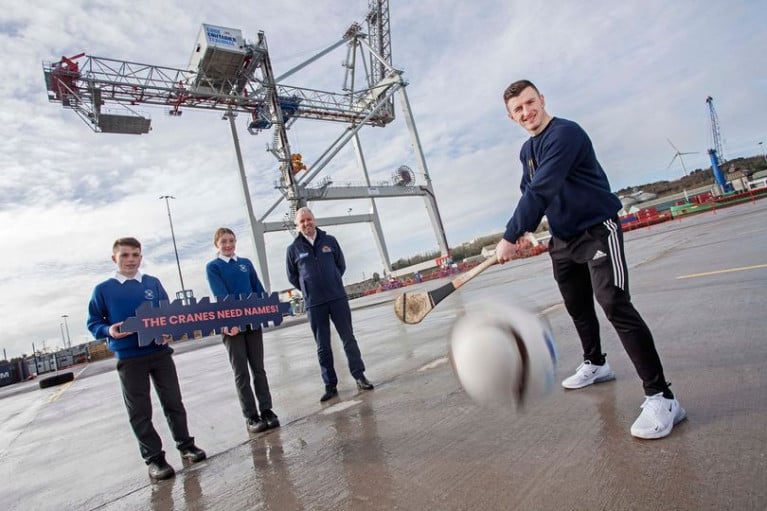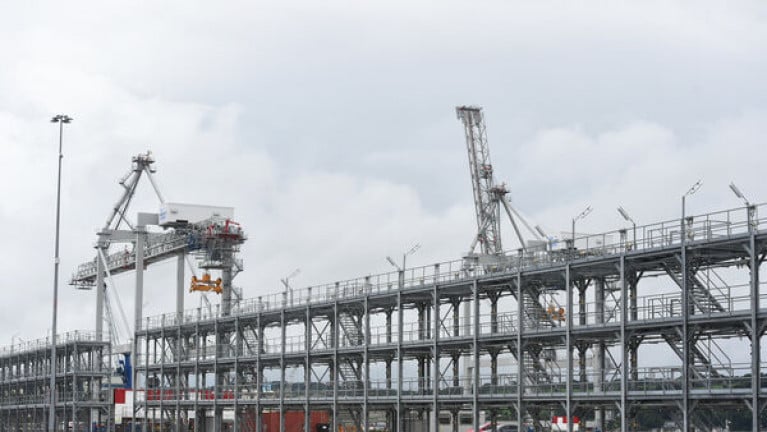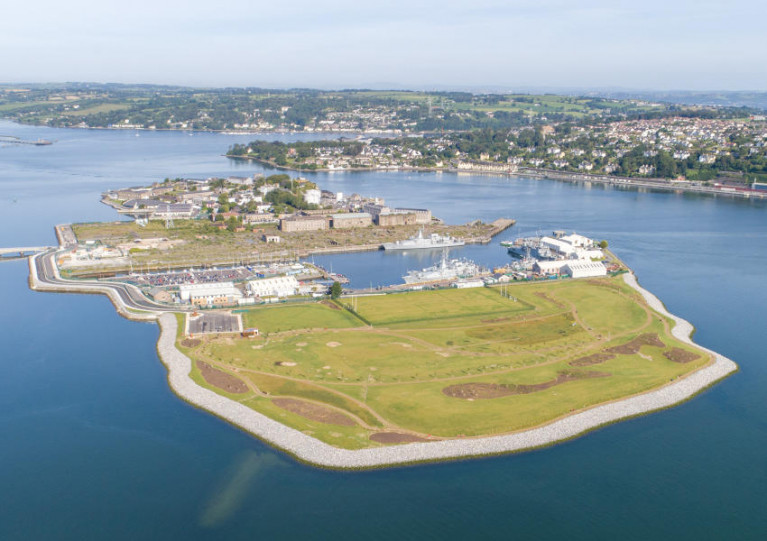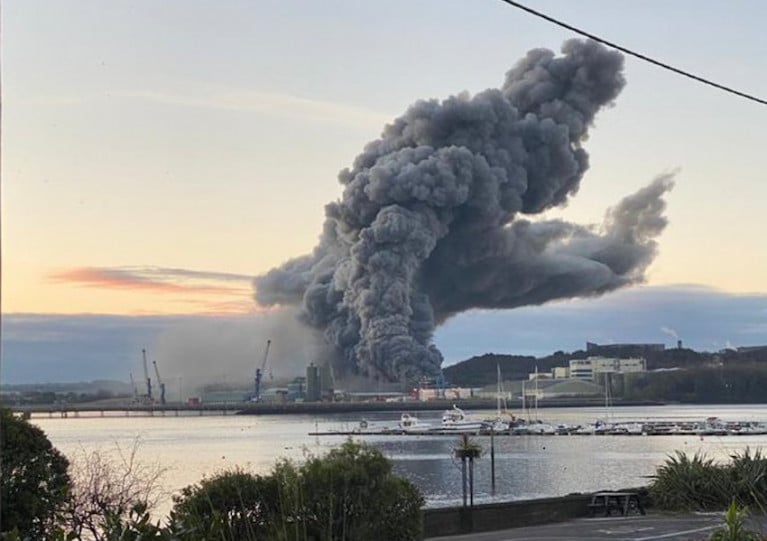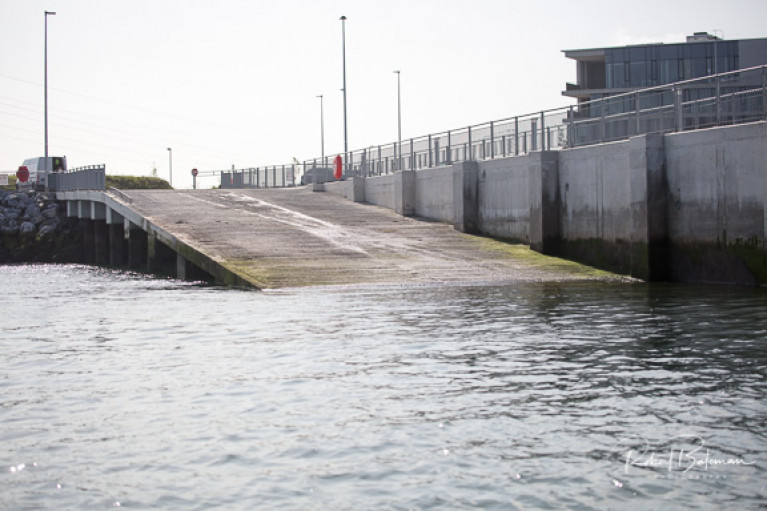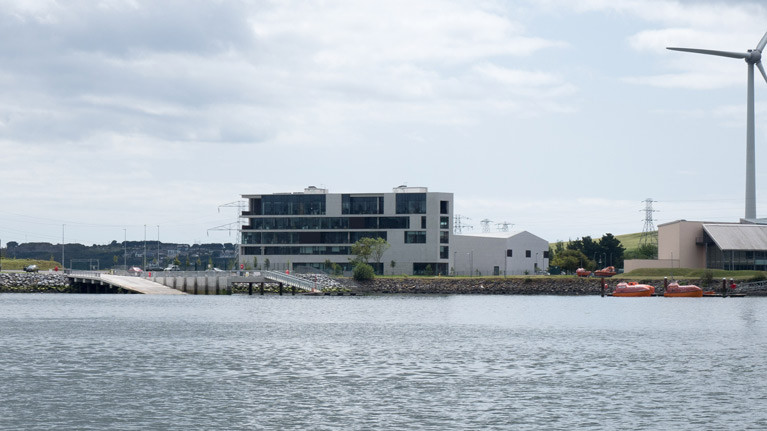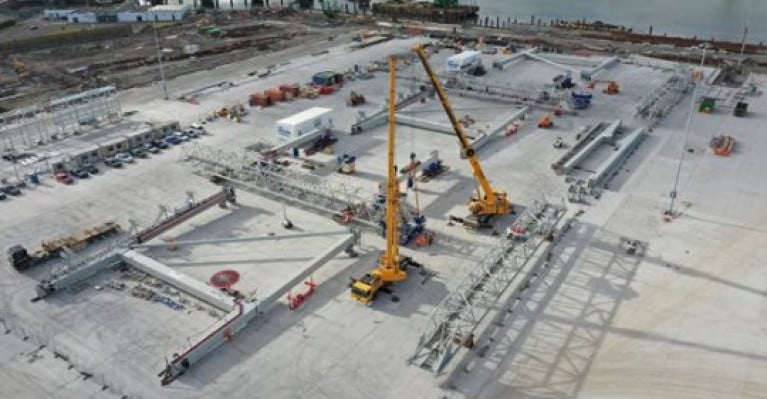Displaying items by tag: Ringaskiddy
Hopes for Concrete Blocks With Imprint of Ringaskiddy Shoreline to Boost Biodiversity in Dublin Bay
Dublin’s Great South Wall has taken on the appearance of the Cork Harbour shoreline thanks to a new biodiversity project.
According to RTÉ News, a series of large concrete blocks imprinted with a mould of the Ringaskiddy coastline have been placed at the foot of the wall — providing a rougher topography that is hoped will be a safe haven for marine micro-organisms to thrive.
Researchers at UCD who developed the scheme chose the nooks and crannies on the water’s edge at Ringaskiddy above more than 60 other shorelines, both naturally rocky and human-made, as the model for their project in collaboration with the Dublin Port Company.
And if the Dublin Bay experiment is successful, then Ringaskiddy’s topography could be replicated on sea walls, piers and other structures around the country.
RTÉ News has more on the story HERE.
Port of Cork Company Celebrates Bumper First Year at Cork Container Terminal
Over 90,000 containers were loaded and discharged at the Port of Cork Company’s new Cork Container Terminal (CCT) in Ringaskiddy in what was a bumper first year at the state-of-the-art facility.
The Cork Harbour terminal, which is the result of a €94 million investment, became operational in April 2022 with an official launch on 23 September 2022.
In its inaugural year, 46,932 containers were discharged at CCT and 48,282 containers loaded onto a total of 340 ships which docked at the deepwater facility. On average, 280 containers were loaded and discharged per ship.
Commenting on CCT’s first year in operation, Conor Mowlds, the Port of Cork Company’s chief commercial officer said: “The launch of CCT last year was a hugely important milestone for the Port of Cork Company as it marked the culmination of years of significant planning, investment and development in this vital facility to ensure the port’s ongoing competitiveness.
“CCT represents the largest single investment in marine infrastructure of any Irish port over the last 100 years and has enabled the port to deliver more efficient container handling facilities, strengthening Cork’s position as an international gateway for trade.”
The container terminal in Ringaskiddy is one of the largest deep-water, multimodal berths in the world at 13 meters deep and 360 metres long.
The official opening of CCT was followed by another significant milestone for the company in May this year with the launch of the Port of Cork Masterplan 2050, which will see further development of the CCT site.
Among the key points in the masterplan, the company says that the delivery of the M28 will enable further relocation of its activities from Tivoli Docks to Ringaskiddy and unlock significant port capacity in the lower harbour.
Supporting the accelerated growth of the fixed offshore renewable energy (ORE) sector is another important component of the plan which charts a course to a new sustainable and secure future for the port.
€89m Cork Harbour Terminal Opened
Cork Port Company has formally opened its €89m deepwater container terminal at Ringaskiddy with an announcement that it is formulating a development plan for the harbour up to 2050.
The new terminal is described as "the largest single investment in marine infrastructure of any Irish port over the last 100 years." It has been operational since April, providing multimodal berths in the world, 13-metres in depth and 360 metres in length.
The Port Company says: "When fully operational, on completion of the M28 road network" it will have the capacity to handle 330,000 TEUs. . This road is the subject of protests and concerns from local residents but has Government approval.
At today's official launch Minister Hildegarde Naughton with special responsibility for transport and logistics, said that "Maritime transport accounts for more than 90% of Ireland's international trade, and the Port of Cork has played an integral role in keeping Ireland connected, as part of the global transport system."Cork and Dublin are the only ports in Ireland capable of servicing all six shipping modes – lift-on/lift-off, roll-on/roll-off, liquid bulk, dry bulk, break bulk and cruise.'
Cork Port Company Chairperson, Michael Walsh, said the container port is only the first phase of an overall proposed development plan for the Port of Cork:
"This is the beginning of an exciting new chapter at Port of Cork as we seek to meet the next phase of needs of our community and customers. As we look forward towards a Vision for 2050, we see huge potential for our harbour to continue its role as a focal point for our community to live in and enjoy, as well as a key gateway for global.
"We would like everyone’s help in developing a new Masterplan to 2050, which will act as a blueprint for the future growth and development of the Port of Cork. I encourage our local community, customers and national stakeholders to share their ideas when we launch a consultation on our draft plan in the coming weeks.”
The Ringaskiddy development went ahead only after intense local opposition.
Details of a "blueprint for the growth to 2050" are to be delivered "in the months ahead, following public consultation," according to the Port Company.
Eoin McGettigan, Port CEO, PoCC, said: “It is really important to us that we work with our colleagues, neighbours and customers in the local area to make sure that the development of the Port of Cork is something that everyone is proud of."
Competition in Cork for Kids to Name Giant Cranes at New Ringaskiddy Container Terminal
Two new giant cranes at the Port of Cork that tower over the new Ringaskiddy container terminal have yet to be named.
And now Port of Cork are calling on schoolkids from all around Cork Harbour to come up with their best suggestions as they launch the 'Name The Cranes' competition.
Cork hurling star Patrick Horgan joined local schoolkids and reps from the Port of Cork Company to help launch the search for names for the mighty ship-to-shore cranes which dominate the skyline, standing at over 50 metres tall at the new container facility in Ringaskiddy.
The new cranes and the giant terminal at Ringaskiddy will be officially opened later this year. But to find out more on how to join in the fun and name those cranes, you can visit the Port of Cork facebook page.
Cork Beo has more on the competition to name the giant ship to shore (STS) container gantry cranes.
A massive development in the Port of Cork of a new container handling terminal at Ringaskiddy, is almost complete and, when operational, will future-proof the transit of imports and exports for Ireland.
Work on the €86m project - the biggest single investment ever made by the Port of Cork - started in 2018. It has been a huge undertaking, involving the dredging of 285,000 tonnes of silt and rock, the laying of 92,000 sq m of concrete and the development of 2kms of new roads at the 150-acre site.
A lot of the silt was buried at sea, close to Roche's Point, under an EPA licence, while most of the rock was ground up and used for infill at the site.
Jim Murphy, project and development engineer with the Port of Cork, explained that the new 360m-long quay (equipped with STS gantry cranes) had a 13m depth of water, meaning it is capable of handling the biggest container ships in the world.
“They are typically 300m long and 16 containers wide. The containers are 40ft long each and the Ringaskiddy terminal will be able to handle 280,000 of these containers every year,” Mr Murphy said.
 Port of Cork's new gantry cranes Photo: Bob Bateman
Port of Cork's new gantry cranes Photo: Bob Bateman
This is approximately 40,000 more containers than can be handled (upriver) at Tivoli, where operations will start to be phased out once Ringaskiddy is fully up and running.
Further Irish Examiner coverage of the port project here.
Haulbowline Amenity Park Opens to the Public This Friday
Haulbowline Island Amenity Park in Ringaskiddy will be open to the public from tomorrow, Friday 15 January, Co Cork’s mayor has confirmed.
The park includes 4km of harbour-side walkways, a 1km jogging circuit and numerous seating areas to stop and take in the views of Cork Harbour.
It has also been extensively landscaped with wildflower areas and more than 200 trees, and is rich with biodiversity and wildlife.
Mayor of the County of Cork, Cllr Mary Linehan Foley welcomed the opening of the park and noted the value of safe areas for outdoor recreation, which are especially welcome at these times.
“Covid-19 restrictions have seen a huge uptake in people using our parks, beaches and greenways to get exercise within their 5km,” she said.
“Haulbowline Island Amenity Park will be a fantastic asset, particularly to the people of Ringaskiddy and the immediate surrounding area.
“People living outside 5km from the park will have to wait to visit Haulbowline but it will be worth the wait for the spectacular views of Cork Harbour.”
Cork County Council chief executive Tim Lucey noted the level of transformation that has taken place in the development of the park.
“The most innovative and customised solutions have been applied throughout with spectacular end results: excellent amenities and the establishment of woodlands and wildflower areas,” he said.
A spokesperson for Ringaskiddy and District Residents Association welcomed the opening of the park and highlighted the value of this amenity to local residents noting that “any environmentally-friendly recreational amenities are most welcome and long overdue for our community”.
Haulbowline Island Amenity Parkis gated and will be open to the public daily from 9am to 4.30pm in the winter months, with spring and summer hours to be decided.
Blaze at Cork Harbour Grain Store ‘Was Third in Four Months’
Yesterday’s fire at a grain storage facility in Ringaskiddy was the third such incident in the past fourth months, firefighters have said.
According to The Irish Times, concerns have been brewing as it emerged that local residents learned of the blaze from the media rather than the Port of Cork and Cork County Council’s notification system.
As previously reported on Afloat.ie, the fire at the Ringaskiddy deepwater port on Saturday (9 January) sent a huge plume of smoke into the air over Cork Harbour and saw shipping operations suspended for much of the day.
Ringaskiddy Residents in Cork Harbour say they have been told to stay indoors and shut windows due to fire in Cork Port. pic.twitter.com/9HeVTjJ5T2
— Tom MacSweeney (@TomMacSweeney) January 9, 2021
Despite the risk of a dust explosion, the fire was quickly brought under control and no injuries were reported.
But the blaze — fuelled by what the council described as “natural, organic animal feed” — caused extensive damage to the R&H Hall depot.
And area residents were advised to close their windows to protect from smoke and fumes, prompting concern from local campaigners against a proposed incinerator for the Cork Harbour village.
The Irish Times has much more on the story HERE.
Cork Harbour's Impressive Slipway & Marine Facilties at Paddy's Point in Ringaskiddy
As Afloat reported in July, the new public recreation area at Paddy's Point in Cork Harbour now has a new floating pontoon added to the existing marine leisure facilities at Ringaskiddy.
As it turns out, the new facilities were about to be put to championship use in August to handle a fleet at the Laser National Championships until the event had to be cancelled by Royal Cork Yacht Club due to COVID concerns.
The pier and slipway, that opened in May 2019 is located adjacent to the Beaufort Building in Ringaskiddy and is managed and maintained by the Port of Cork.
The substantial new facilities replace the existing Ringaskiddy slipway and pier and were completed as part of the Cork container terminal development.
 This new marine leisure facility is free for the public to use and includes a pontoon to launch leisure craft Photo: Bob Bateman
This new marine leisure facility is free for the public to use and includes a pontoon to launch leisure craft Photo: Bob Bateman
These latest photos of Paddy's Point further illustrate what a fine structure is now in situ and what a welcome addition it is to Cork Harbour's marine infrastructure.
New Cork Harbour Slipway & Pier Facility at Paddy's Point Includes Floating Pontoon & Gangway
The new public recreation area at Paddy's Point in Cork Harbour now has a new floating pontoon added to the existing marine leisure facilities at Ringaskiddy.
The pier and slipway, that opened in May 2019 is located adjacent to the Beaufort Building in Ringaskiddy and is managed and maintained by the Port of Cork.
The substantial new facilities replace the existing Ringaskiddy slipway and pier and were completed as part of the Cork container terminal development.
This new marine leisure facility is free for the public to use and includes a pontoon to launch leisure craft and a secure trailer park along with picnic benches in a landscaped area for all to enjoy.
 Paddy's Point new Marine Leisure facilties in Cork Harbour at Ringaskiddy Photo: Bob Bateman
Paddy's Point new Marine Leisure facilties in Cork Harbour at Ringaskiddy Photo: Bob Bateman
Assembling of Ship-to-Shore Cranes for Port of Cork's New Container Terminal
The assembling of ship-to-shore (STS) cranes has begun at the Port of Cork's new Container Terminal in Ringaskiddy.
The new Liebherr cranes according to the port company, will improve liners’ schedule reliability, and reduce trade costs and inventory holding outlays for shippers
In an announcement yesterday, the Port said it has taken delivery of two Liebherr post-panamax size (STS) container gantry cranes at the Cork Container Terminal. The assembly process has commenced on site and is due to be completed in the coming weeks.
The Port of Cork is the second largest port in the Republic of Ireland in terms of turnover. In 2019 the port handled total container traffic of 240,000 TEU. Thanks in part to the new Liebherr STS cranes, this is expected to increase by more than37% to approximately 330,000 TEU over the next decade in Cork Container Terminal.
Henry Kingston, Port Engineering Manager of the Port of Cork, said: “Liebherr Container Cranes in Killarney have been working with the Port of Cork for more than 50 years, and their port cranes, ship-to-shore container cranes, and rubber tyre gantry cranes (RTG) have been integral to making us the most seamless trade gateway in Ireland. Our first-hand experience of the top quality of Liebherr products and the first class after sales service back-u were key factors in influencing the decision to choose Liebherr for this project. In 2012, the Port of Cork and Liebherr collaborated in pioneering the very first fully electrically powered E-RTG crane in Ireland which has proven to be super reliable, as well as environmentally best in class.”
CCT will soon become a major enabler of growth for Cork city and Munster as well as the national economy. The funding for this development has come from Allied Irish Banks plc (AIB), the European Investment Bank (EIB), and the Ireland Strategic Investment Fund (ISFI), European Connecting Europe Facility Funds as well as self-finance, and these STS cranes will be core contributors to CCT’s growth in the 2020s and beyond.
The cranes were built less than 100 kilometres from Cork in Killarney, County Kerry, and are being assembled by local crane erection specialists William O’Brien Group., under the supervision of expert Liebherr engineers. Liebherr Container Cranes Ltd. is part of the Liebherr group and supplies container handling equipment to ports and rail terminals worldwide.
David Griffin Managing Director – Sales, Liebherr Container Cranes, said, “Port of Cork has a well-established reputation for fast ship turnarounds and facilitating efficient supply chains, so Liebherr was very satisfied to be the preferred choice to meet the Port’s high standards. These new cranes are fitted with the latest energy saving Liebherr Liduro drives, power management systems and safety features available in today’s STS crane markets. The cranes will have an outreach of 45m, a back reach of 15m and a lift height over rail of 32m, ensuring that they will have the lift and reach capacity to cater for the largest container vessels which will visit Cork in the coming decades.”
“Liebherr Container Cranes are industry leaders in terms of their high reliability, low downtimes and low maintenance and running costs, and will serve Cork Container Terminal well into the future.”
The contract was awarded to Liebherr in 2018 after a public tender process, and the opening of CCT later this year will deliver the fastest, most reliable, and cost-efficient container service available to local businesses as well as Ireland’s international exporters.
Construction on CCT began in June 2019 and will finish in 2020. The €80m project will initially offer a 360-metre-long quay with a 13-metre depth alongside. The development also includes the construction of a 13.5-hectare terminal and associated buildings.


























